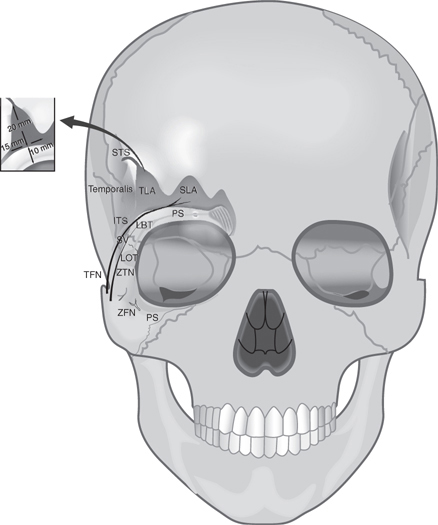Where is the normal brow position?
Normal brow position differs for men and women. Men typically have a low straight brow at the level of the upper orbital rim. Women have a slightly higher brow above the rim with an arch or peak two-thirds of the way across its horizontal axis.
 What are the indications for surgical rejuvenation of the upper face?
What are the indications for surgical rejuvenation of the upper face?
Soft tissue ptosis of the forehead, eyebrow, temporal regions, forehead height disparities, and permanent static glabellar and forehead lines.
 What muscle is responsible for brow elevation?
What muscle is responsible for brow elevation?
The frontalis muscle is responsible for brow elevation. It is innervated by the frontal branch of the facial nerve.
 What muscles are responsible for brow depression?
What muscles are responsible for brow depression?
The corrugator supercilii, depressor supercilii, procerus, and orbicularis oculi muscles can all depress the brow.
 What muscles are innervated by the frontal branch of the facial nerve?
What muscles are innervated by the frontal branch of the facial nerve?
The frontalis, corrugator, procerus, and depressor supercilii muscles.
 What is the origin and insertion of the corrugator muscles?
What is the origin and insertion of the corrugator muscles?
The origin is from the frontal bone near the superomedial orbital rim lateral to the origin of the procerus muscles. The corrugators insert into the dermis of the forehead skin above the middle third of the eyebrow.
 What is the result of division or resection of the corrugator muscles?
What is the result of division or resection of the corrugator muscles?
Corrugators pull the brows medially and cause vertical wrinkling. Division will diminish vertical wrinkling in the glabellar area. With the corrugators weakened or resected the brow can spread apart and widen. Over-resection in this area can also lead to a contour depression and sometimes a strange appearance with animation.1
 What nerve is encountered and preserved during resection of the medial aspect of the corrugator muscles?
What nerve is encountered and preserved during resection of the medial aspect of the corrugator muscles?
The supratrochlear nerve.
 Where is the origin of the procerus muscle?
Where is the origin of the procerus muscle?
The origin is in a paramedian location over the nasal bones inferior and medial to the origin of the corrugator muscles. These muscles are responsible for medial brow depression and horizontal rhytids over the radix.
 What is brow strain and what is it a possible sign of?
What is brow strain and what is it a possible sign of?
Brow strain is a state of chronic frontalis muscle contraction and brow elevation. Deep horizontal forehead rhytids and an active elevated brow position are apparent on examination. Patients are often unaware of this condition. Common causes are upper lid ptosis and/or excess upper eyelid skin, both of which can obstruct the upper visual field (visual field defect).
 What is the “Mephisto brow”?
What is the “Mephisto brow”?
This is an unnatural brow position oftentimes due to overapplication of botulinum toxin to the medial aspect of the brow and the frontalis muscle. It appears as a severe medial brow depression and lateral brow elevation for an overall deeply medially angulated brow and sinister appearance. “Mephisto” is short for Mephistopheles, a literary demon in the legend of Faust. It can be treated by application of botulinum toxin to the temporal aspect of the frontalis muscle and relaxing the lateral brow.
 Describe the retaining ligaments of the brow and temple.
Describe the retaining ligaments of the brow and temple.
The retaining ligaments of the brow and temple are numerous and dense. Knowledge of their location and subsequent release during brow lift procedures will enhance results. The supraorbital ligamentous adhesions traverse the horizontal aspect of the upper orbital rim. They terminate laterally into the temporal ligamentous adhesion (TLA), a dense ligamentous adhesion over the upper lateral aspect of the orbital rim and temple adjacent to the sentinel vein. Emanating from the TLA are the superior temporal septum (a ligamentous septum along the upper terminating border of the temporalis muscle with the frontal bone periosteum) and the inferior temporal septum (see Fig. 5-1).
Figure 5-1 STS, superior temporal septum; TLA, temporal ligamentous adhesions; SLA, supraorbital ligamentous adhesions; ITS, inferior temporal septum; LBT, lateral brow thickening; PS, periorbital septum; SV, sentinel vein; LOT, lateral orbital thickening; ZTN, zygomaticotemporal nerve; TFN, temporal branch of facial nerve; ZFN, zygomaticofrontal nerve.
Stay updated, free articles. Join our Telegram channel

Full access? Get Clinical Tree



